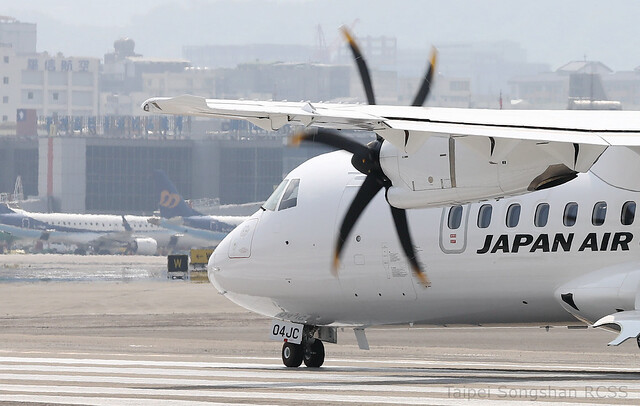Garuda B733 at Malang on Jul 22nd 2011, hard landing
Last Update: July 23, 2014 / 22:01:04 GMT/Zulu time
Incident Facts
Date of incident
Jul 22, 2011
Classification
Report
Cause
Hard landing
Airline
Garuda Indonesia
Aircraft Type
Boeing 737-300
ICAO Type Designator
B733
During the circle to land approach, the aircraft was turned too early that might cause the aircraft higher above the normal approach path and not on the correct track and was taken over by the PIC.
The approach was un-stabilized until below 300 feet and the absent of reminder from the other crew to go-around. These actions inconsistent to the operator standard operating procedures as well as the CRM philosophy.
The NTSC reported that the touch down produced a vertical acceleration of +3.473G.
The NTSC analysed that during final approach, below 500 feet the speed reduced to 118 KIAS (Vref was 130 KIAS) prompting the first officer, now pilot monitoring to call the speed. Any speed deviation below Vref immediately fulfills the criteria of an unstable approach and should have prompted a go-around.
The NTSC analysed that the pitch oscillated creating a rate of descent of up to 1080 fpm, any rate of descent above 1000 fpm requires a go-around due to violation of stabilized approach criteria.
The bank angle varied from 9 to 21 degrees, there was no specification of the bank angle within the stabilized approach criteria however.
The NTSC stated: "Refer to the recorded data in the FDR indicated that the aircraft was on unstabilized approach while in an VMC condition until below 300 feet which required to go-around."
The NTSC analysed that the captain assessed the first officer under line training would not be able to handle and correct the approach and therefore took control of the aircraft. The Boeing flight crew manual states however: "Any significant deviation from planned flight path, airspeed, or descent rate should be announced. The decision to execute a go-around is no indication of poor performance. Note: Do not attempt to land from an unstable approach."
Although the aircraft was not within the criteria of stabilized approach below 300 feet AGL, there was no call to go around or call the unstable approach. The NTSC stated: "the PIC decision to take over control and continued the approach on an un-stabilized approach and absent of reminder from the other crew was not consistent with the operator standard operating procedures as well as the CRM Policy."
Incident Facts
Date of incident
Jul 22, 2011
Classification
Report
Cause
Hard landing
Airline
Garuda Indonesia
Aircraft Type
Boeing 737-300
ICAO Type Designator
B733
This article is published under license from Avherald.com. © of text by Avherald.com.
Article source
You can read 2 more free articles without a subscription.
Subscribe now and continue reading without any limits!
Read unlimited articles and receive our daily update briefing. Gain better insights into what is happening in commercial aviation safety.
Send tip
Support AeroInside by sending a small tip amount.
Related articles
AeroInside Yearly Aviation Safety Review 2025
2025 is over and it is time to look back and see again what happend in aviation safety. Have a look at our summary below.All in all, 1041 new…
AeroInside Monthly Aviation Safety Review December 2025
December 2025 was a busy month in aviation safety. Please find our summary below.All in all, 63 new articles have been published during last month. 5…
Flight Training Stress: Navigating Turbulence as a Student Pilot
Becoming a pilot is a thrilling and rewarding experience, but the path to the cockpit is often filled with challenges, especially when it comes to…
Aero Ventures Managing Partner Sergey Petrossov: 'We're Not Replacing the Human Side of Aviation, We're Elevating It'
Private aviation has resisted digital transformation longer than most asset-heavy industries. Aircraft ownership transactions often still operate…
AeroInside Monthly Aviation Safety Review November 2025
November 2025 was a busy month in aviation safety. Please find our summary below.All in all, 59 new articles have been published during last month.…
Newest articles
JAC AT42 at Amami on Jan 5th 2026, hydraulic failure
A JAC Japan Air Commuter Avions de Transport Regional ATR-42-600, registration JA04JC performing flight JL-3837 from Amami O Shima to Kikaiga Shima…
Emirates B772 over Saudi Arabia on Jan 4th 2026, loss of cabin pressure
An Emirates Boeing 777-200, registration A6-EWB performing flight EK-929 from Dubai (United Arab Emirates) to Cairo (Egypt), was enroute at FL360…
Subscribe today
Are you researching aviation incidents? Get access to AeroInside Insights, unlimited read access and receive the daily newsletter.
Pick your plan and subscribePartner

ELITE Simulation Solutions is a leading global provider of Flight Simulation Training Devices, IFR training software as well as flight controls and related services. Find out more.
SafetyScan Pro provides streamlined access to thousands of aviation accident reports. Tailored for your safety management efforts. Book your demo today
AeroInside Blog
Popular aircraft
Airbus A320Boeing 737-800
Boeing 737-800 MAX
Popular airlines
American AirlinesUnited
Delta
Air Canada
Lufthansa
British Airways


